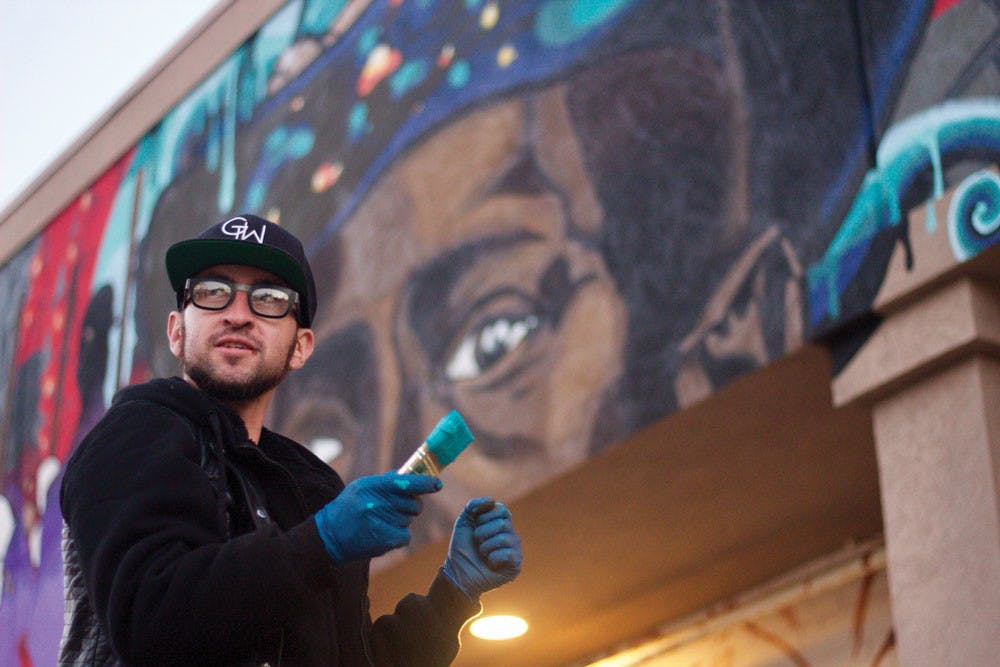The mural spans the length of Indigo Salon on the edge of Mercer Village on Coleman Avenue.
It is made up of vibrant hues of purple and blue spray paint, highlighted with white, shaded in black.
In the center stands Martin R. Delany, who served as the first African-American field grade officer in the U.S. Army during the American Civil War. He was active in recruiting African-Americans for the United States Colored Troops on the Union Army side.
A group of black Civil War soldiers stand behind him.
Beside Delaney is Sam Oni, Mercer’s first black student from Africa.
The mural is made up of several layers of symbolism. The first layer is a commentary on the consideration of confederate monument removal.
“All my work is activist-based,” said muralist and graffiti artist Joereal Elliott.
A silhouette of Rosa Parks seated on the famous Montgomery, Alabama bus stands in the background of the painting.
Her booking number 7053 from her arrest is just beneath her.
 Thais Ackerman
Thais Ackerman
Craig Coleman, Mercer associate professor of art, said that it was a student living in the apartments across from the mural that suggested to Elliott that Parks be added to the piece.
“It’s about using your body as a voice,” Elliott said.
The individuals in the mural are painted in different positions from standing and sitting to kneeling.
Two football players kneel on either side of Delany, paying a nod to the ongoing National Anthem protest that began in 2016.
The protest calls attention to racial inequality and police brutality issues in the U.S.
The second layer is about the need for greater equal rights in America.
Many of Elliott’s works have been equal rights pieces, especially regarding Native Americans.
The Mercer Village mural is the last project spearheaded by the university’s art department “Art in the Park” series funded by the Knight Neighborhood Grant.
The murals official unveiling took place on Nov. 17 at noon.
The mural was presented to about a dozen spectators comprised of Mercer students, faculty and Macon community members.
Elliott spoke on behalf of his piece in detail and the event concluded with a light reception.
The unveiling was part of a two-week program that featured two lectures about graffiti art and activism, and a workshop about graffiti style and spray paint can control.
Originally from San Angelo, Texas, Elliott is now based in Santa Fe, New Mexico, where he is also a practicing yoga instructor.
As a well-traveled artist, Elliott has been able to incorporate various graffiti and street art styles from around the United States into his own works.
His artistic intentions are to create non-reductive works that cultivate a contemplative space of liberty through living symbolism and the creative unconscious.
[related title="Related Stories" stories="22525,22811,9821" align="right" background="off" border="none" shadow="off"]
“This is my first time in Georgia,” Elliott said.
As a guest artist, Elliott said he wants to paint something that is aesthetically beautiful, but that has depth and is relative to the community.
He said that the city of Macon has great potential to have more legal public art.
“I hope the city and… officials like what I am doing and allow more artists to do more (local art),” Elliott said.
He suggests that the healthy recipe for public art is 60 to 70 percent coming from local community artists and then 30 to 40 percent from the outside.
“The feedback has been very positive,” Coleman said.
Coleman said that the goal of the mural was to widen people’s view on how public art can bring a positive impact to a place and community.
The third layer to the mural is a petition against the proposed Trump wall between the Mexican-United States border.
Each square foot of the painting is a petition of scale to the border wall.
Elliott has already out scaled the prototype Trump wall.
“Typically when artists transform a wall it’s an act of inclusiveness and transforms a community. And, it’s rarely harmful and submissive, like the Trump wall,” Elliott said.
“This mural feels really good,” he said.
Black history mural crowns Mercer Village

Artist Joereal Numina paints a mural on the exterior wall of Indigo Salon on Coleman Avenue in 2017. The mural is named “Cultivating New Tones on the Spectral Stage of History.”




